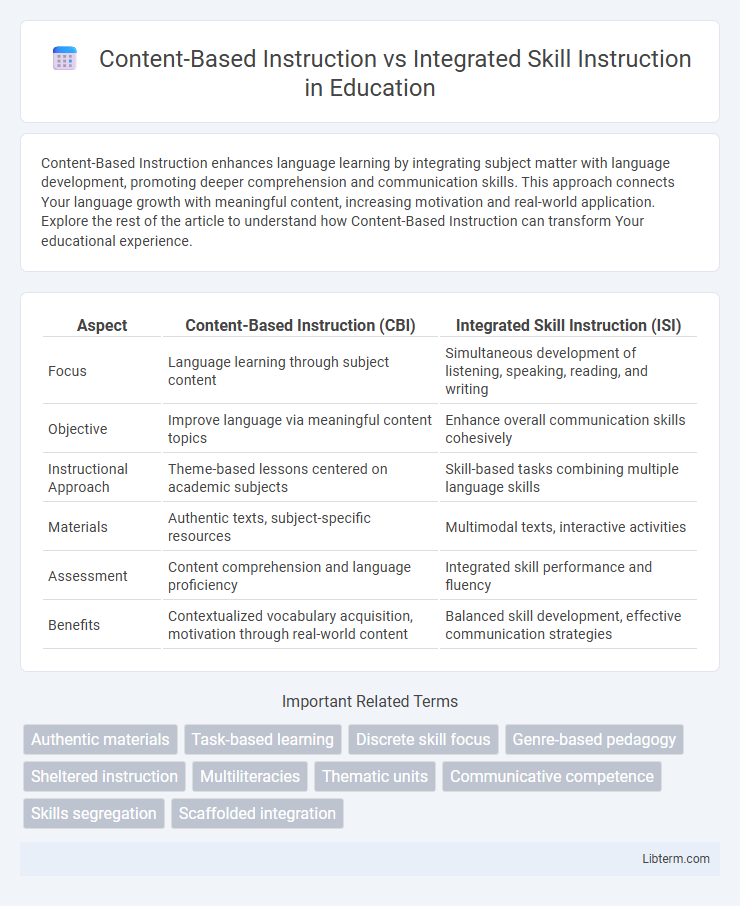Content-Based Instruction enhances language learning by integrating subject matter with language development, promoting deeper comprehension and communication skills. This approach connects Your language growth with meaningful content, increasing motivation and real-world application. Explore the rest of the article to understand how Content-Based Instruction can transform Your educational experience.
Table of Comparison
| Aspect | Content-Based Instruction (CBI) | Integrated Skill Instruction (ISI) |
|---|---|---|
| Focus | Language learning through subject content | Simultaneous development of listening, speaking, reading, and writing |
| Objective | Improve language via meaningful content topics | Enhance overall communication skills cohesively |
| Instructional Approach | Theme-based lessons centered on academic subjects | Skill-based tasks combining multiple language skills |
| Materials | Authentic texts, subject-specific resources | Multimodal texts, interactive activities |
| Assessment | Content comprehension and language proficiency | Integrated skill performance and fluency |
| Benefits | Contextualized vocabulary acquisition, motivation through real-world content | Balanced skill development, effective communication strategies |
Introduction to Content-Based Instruction
Content-Based Instruction (CBI) emphasizes teaching language through subject matter, integrating language skills with academic content for meaningful learning experiences. It promotes the acquisition of vocabulary and grammar within real-world contexts, enhancing cognitive engagement and language retention. CBI contrasts with Integrated Skill Instruction, which focuses on combining listening, speaking, reading, and writing skills without necessarily anchoring them to a specific content area.
Overview of Integrated Skill Instruction
Integrated Skill Instruction combines listening, speaking, reading, and writing skills within a unified lesson, promoting holistic language development and real-world communication. It fosters cognitive connections between language components, enhancing retention and practical application. This method contrasts with Content-Based Instruction, which emphasizes language learning through subject-specific content rather than simultaneous skill integration.
Core Principles of Content-Based Instruction
Content-Based Instruction (CBI) centers on using subject matter as the vehicle for language learning, emphasizing meaningful communication and contextualized vocabulary acquisition. The core principles include thematic organization, where language lessons are structured around academic or real-world content to enhance cognitive engagement and retention. CBI promotes learner autonomy and critical thinking by integrating language skills within content learning rather than treating language as isolated targets.
Key Features of Integrated Skill Instruction
Integrated Skill Instruction combines listening, speaking, reading, and writing skills within thematic units, promoting holistic language acquisition. It emphasizes authentic communication tasks, learner-centered activities, and real-life contexts to enhance engagement and practical use. This approach facilitates simultaneous development of multiple language competencies, fostering greater fluency and retention.
Language Learning Goals in CBI vs Integrated Skill Models
Content-Based Instruction (CBI) prioritizes language acquisition through subject matter content, emphasizing comprehension and vocabulary related to specific academic or professional fields, which enhances contextualized language skills. Integrated Skill Instruction targets balanced development across listening, speaking, reading, and writing, aiming for holistic language proficiency applicable to diverse communication scenarios. CBI's language learning goals focus on mastery of discipline-specific language, while integrated skill models emphasize versatile fluency and communicative competence across multiple language domains.
Classroom Implementation: Strategies and Techniques
Content-Based Instruction (CBI) emphasizes teaching language through subject matter, utilizing authentic texts and thematic units, which fosters meaningful language use and deepens students' content knowledge. In contrast, Integrated Skill Instruction blends listening, speaking, reading, and writing activities within a cohesive lesson, promoting balanced language development through tasks like group discussions, role-plays, and collaborative projects. Effective classroom implementation of CBI involves scaffolding content with visuals and pre-teaching vocabulary, while Integrated Skill Instruction benefits from interactive techniques that encourage active communication and simultaneous skill reinforcement.
Assessment Methods: Comparing CBI and Integrated Skills
Content-Based Instruction (CBI) assessment methods emphasize evaluating students' comprehension and application of subject matter through performance-based tasks, project evaluations, and content-specific tests that measure both language proficiency and academic content mastery. Integrated Skill Instruction assessment combines listening, speaking, reading, and writing skills into holistic tasks, using portfolios, peer assessments, and real-world communication scenarios to gauge overall language competency and practical usage. The key difference lies in CBI's dual focus on content knowledge and language development, while Integrated Skill Instruction prioritizes fluency and balanced skill progression through interconnected language activities.
Advantages and Challenges of Content-Based Instruction
Content-Based Instruction (CBI) enhances language acquisition by integrating subject matter learning with language development, enabling learners to acquire vocabulary and grammar contextually through meaningful content such as science or history. Its advantages include increased learner motivation, deeper cognitive engagement, and improved retention by linking language to real-world topics, though challenges arise with the need for teachers to possess both language teaching expertise and content knowledge, and the potential difficulty in balancing language objectives with content complexity. Effective implementation of CBI requires careful curriculum design and ongoing teacher training to manage these challenges and maximize educational outcomes.
Pros and Cons of Integrated Skill Instruction
Integrated Skill Instruction enhances language learning by simultaneously developing listening, speaking, reading, and writing skills, fostering authentic communication and better context understanding. It promotes learner engagement and practical language use but may overwhelm beginners due to cognitive load from handling multiple skills at once. Balancing skill integration requires careful planning to avoid uneven skill development and ensure effectiveness aligned with learners' proficiency levels.
Choosing the Right Approach: Factors to Consider
Choosing the right approach between Content-Based Instruction (CBI) and Integrated Skill Instruction depends on learners' language proficiency, learning objectives, and content relevance. CBI emphasizes subject matter learning through language development, ideal for students needing strong academic vocabulary and specialized knowledge. Integrated Skill Instruction suits learners aiming for balanced skill enhancement in listening, speaking, reading, and writing, promoting holistic language competence across contexts.
Content-Based Instruction Infographic

 libterm.com
libterm.com